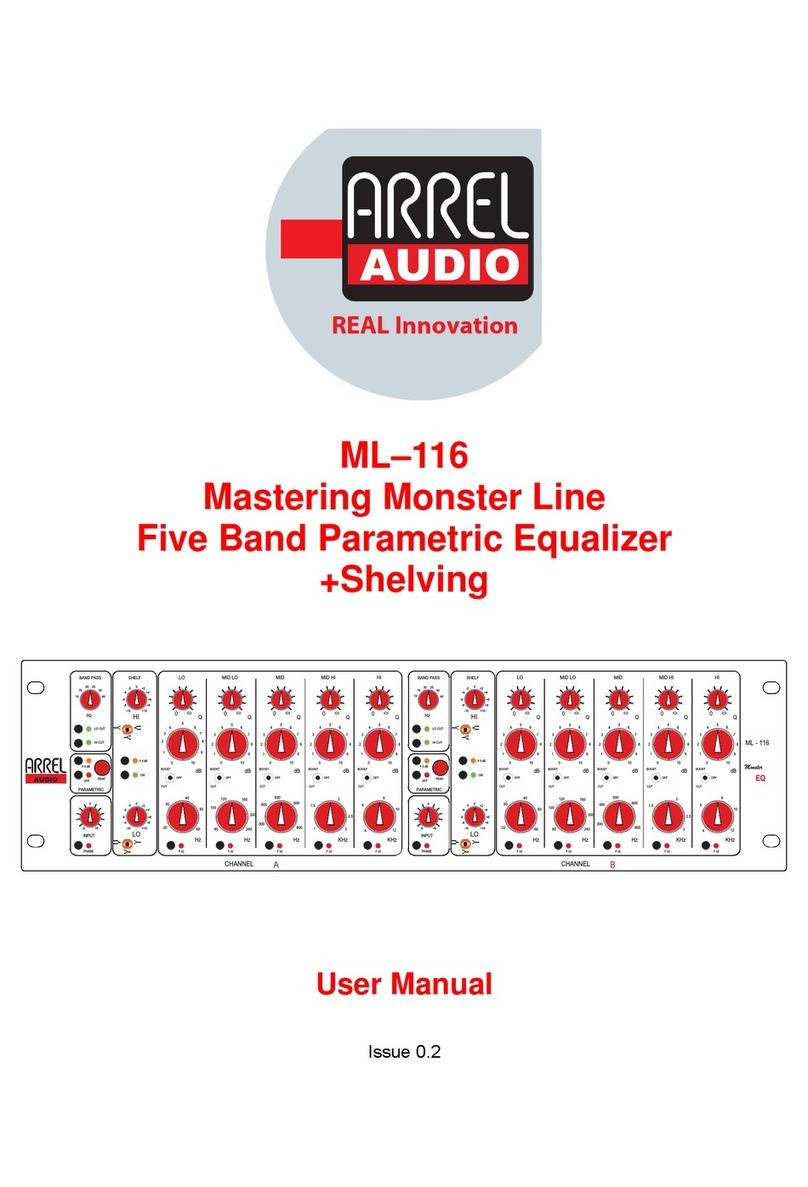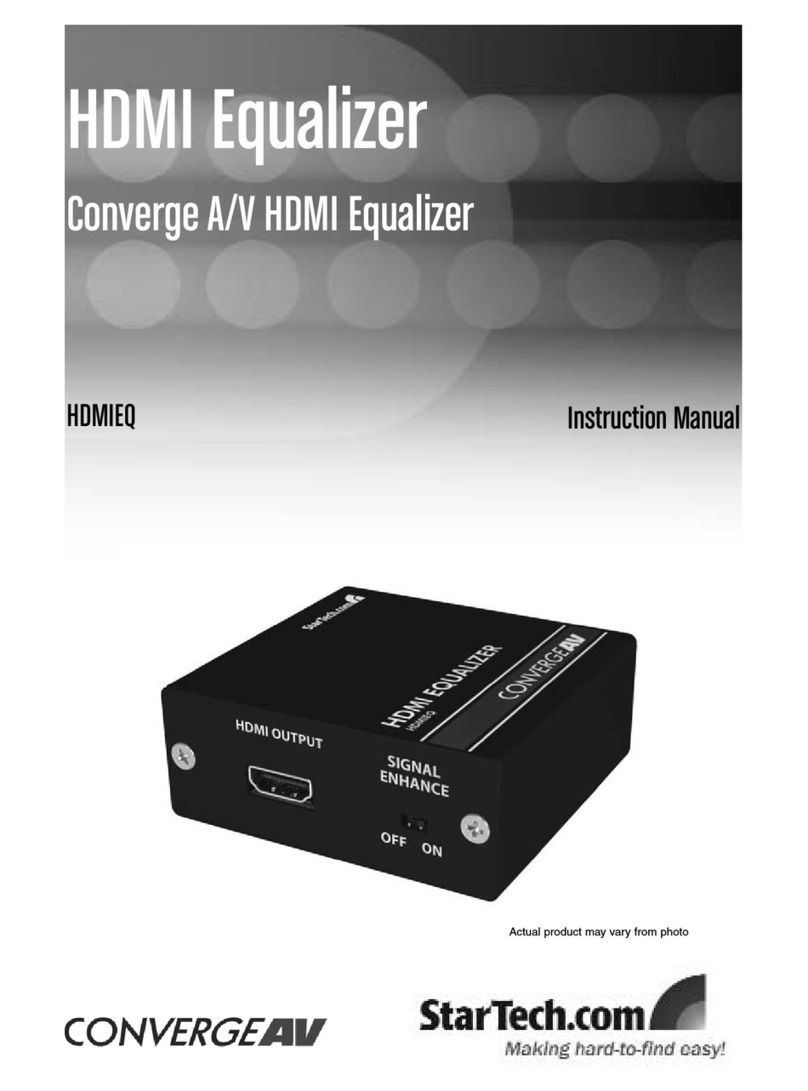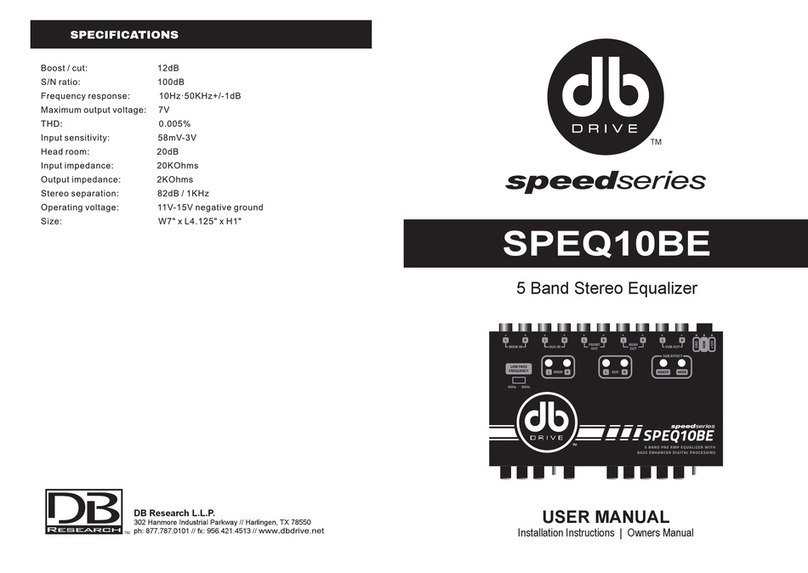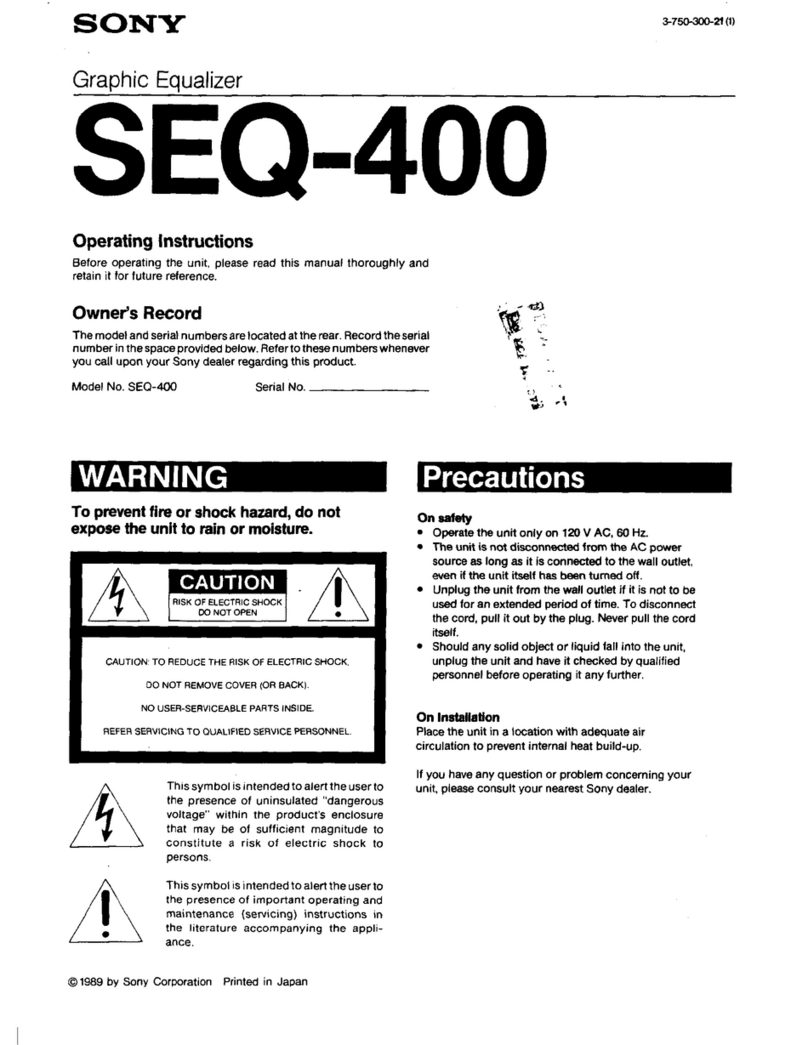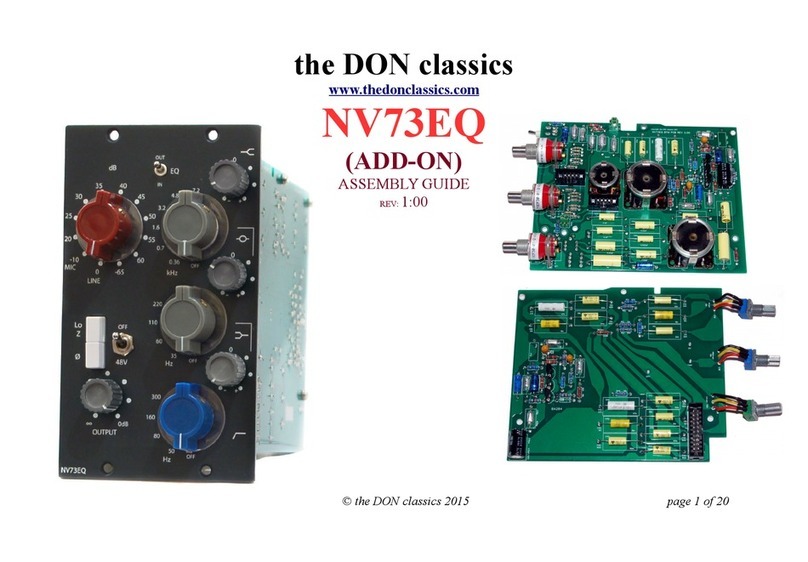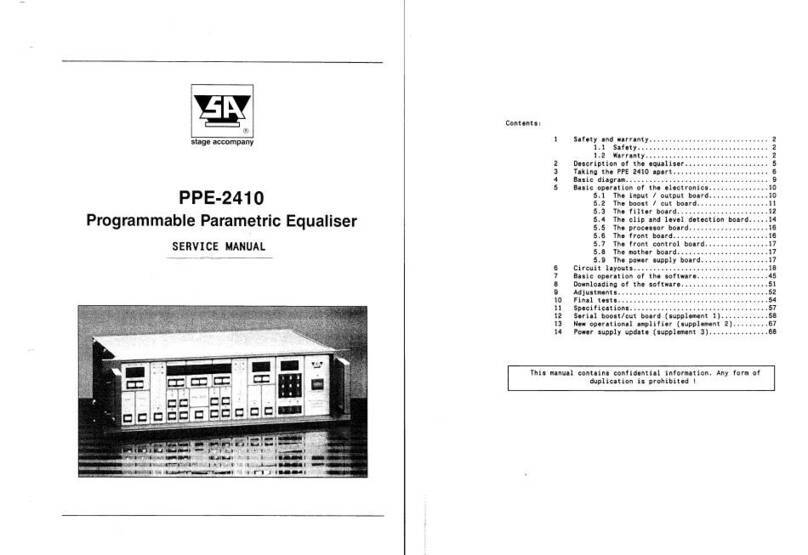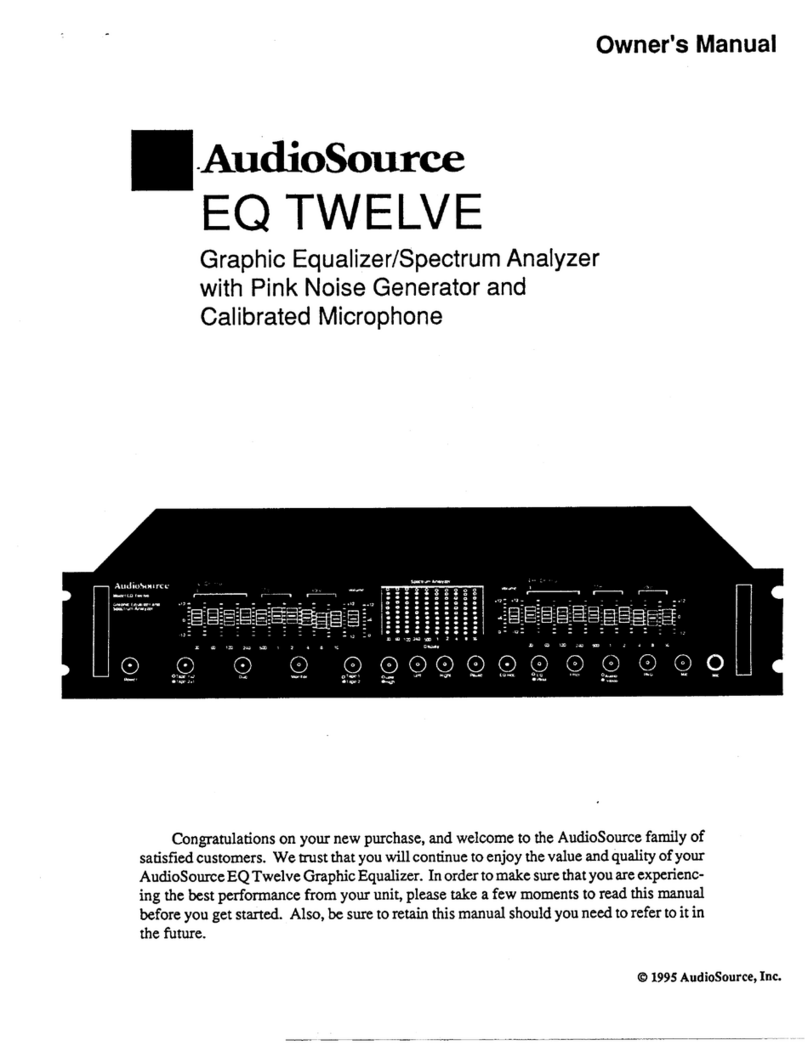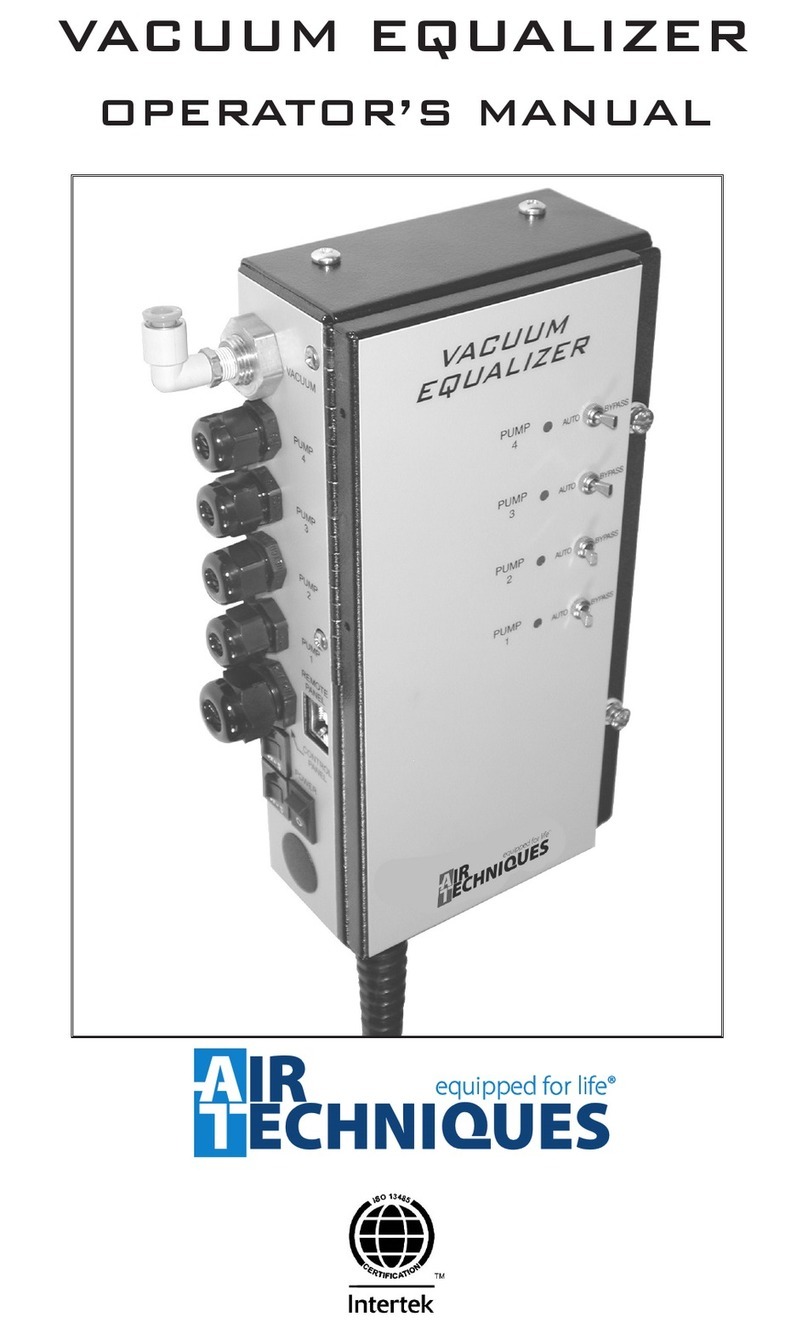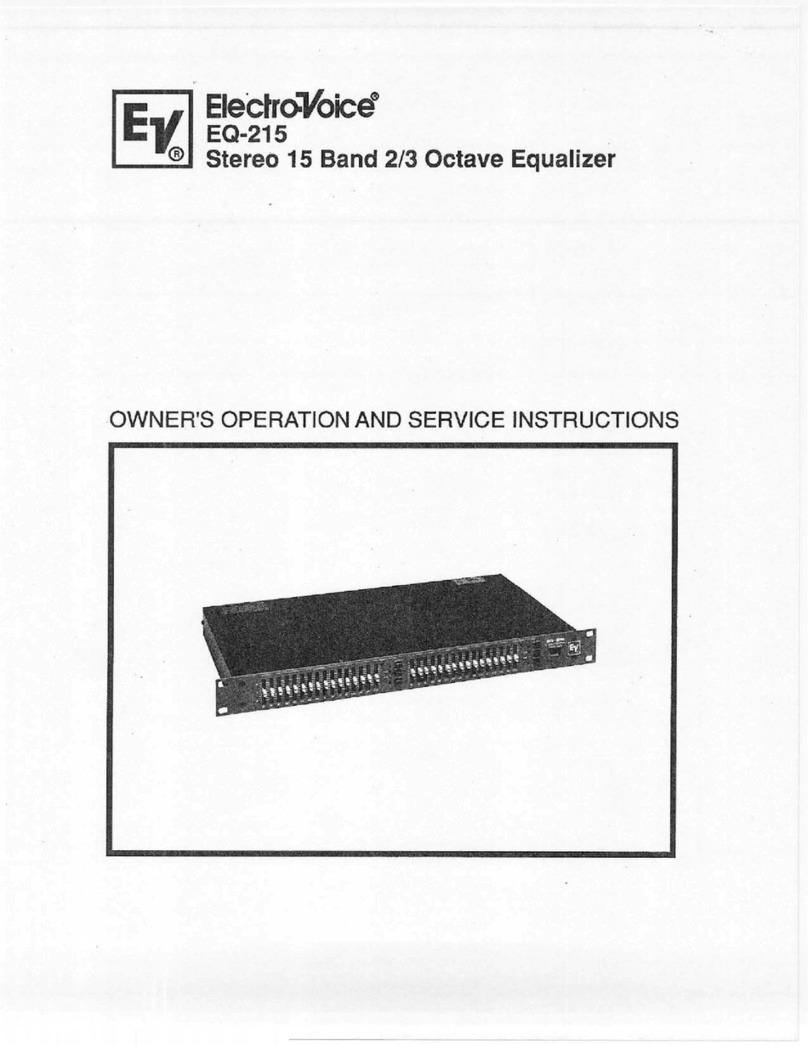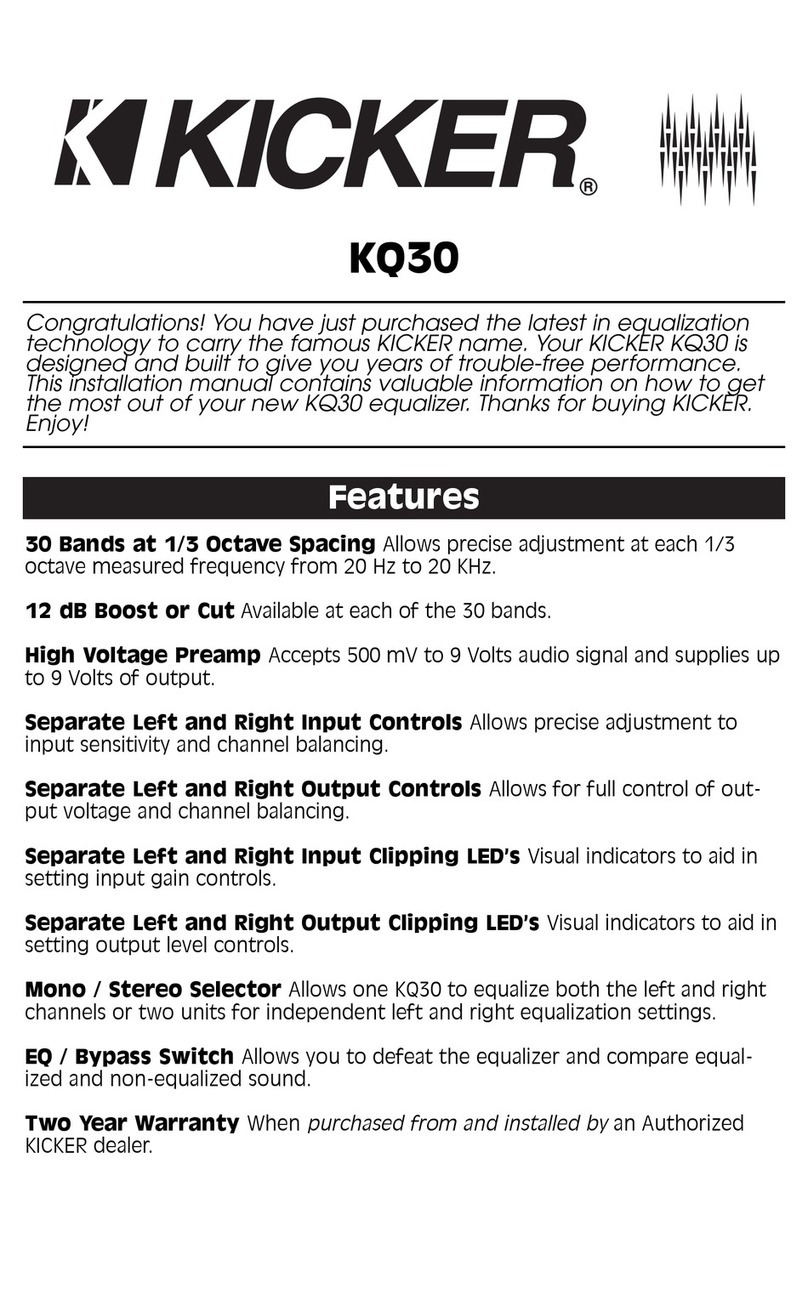THÖRESS PHONO ENHANCER MKIII User manual

THÖRESS
Parametric . Phono Equalizer . Series
=========================
"PHONO ENHANCER MKIII"
................................................................
I N S R U C I O N M A N U A L….........
Thank you for purchasing the THÖRESS Parametric Phono Equalizer!
You have acquire a highly versatile vacuum tube phono preamplifier offering MM
an MC amplification with excellent signal-to-noise performance in purely active
operation mo e (without the ai of built-in step-up transformers) an unique on-
the-fly tone a justments by means of three 6-position rotary switches TCSW1,
TCSW2, TCSW3, which we call tone selectors. The tone selectors give rise to subtle
bass, mi le tone an treble control functions which are highly effective tools for
restoring tonal imperfections of the replaye vinyl program (eventually intro uce
uring the recor ing or cutting process), implemente without involving clumsy an
soun estructive conventional tone control circuitry!
The amplifier is built with meticulous han construction using our proven point-to-
point wiring techniques, whereas much care has been taken in arranging each aspect
of the internal construction to ensure highest reliability, low noise performance an
ease of service for many years to come. Please rea the following explanations an
instructions carefully to get the most out of your phono preamplifier.
INPUTS
The amplifier comprises 6 phono inputs with gain pattern (5xMC+1xMM), five inputs
with 65 B MC gain an one input with 45 B MM gain (presenting a stan ar 47K
loa to the cartri ge). Alternatively, a gain pattern (1xMC+5xMM) can be
implemente on request. However, it is not possible to install an arbitrary MC+MM
gain pattern on the amplifier for technical reasons. The cartri ge loa ing is
(100, 200, 300, 500, 1000 / 47.000) ohms an (500 ohm/47K, 47K, 47K, 47K, 47K).
on (5xMC+1xMC) an (1xMC+5xMM) stan ar units respectively. Other loa values
can be easily installe on eman .
The MC load values installed on each individual MC gain input are printed on the rim of
the rear panel for reference!

It is not possible to install arbitrary MC+MM gain patterns on the Phono Enhancer for
technical reasons!
OUTPUTS
The output impe ance of the amplifier is sufficiently low (aroun 300 ohms) to
simultaneously rive (up to 3) long cable runs an line inputs with an input
impe ance as low as 10.000 ohms without compromising soun quality. The 3 B-
own frequency un er 10.000 ohm loa ing is still well below the au io ban (lower
than 5Hz, output coupling capacitance 3.3MFD). The circuit outputs terminate in 2x3
RCA jacks connecte in parallel. This esign choice is useful for proper (hum-free)
ual-channel mono installation with single-coil cartri ges, without inconvenient
a aptions, as escribe in a e icate paragraph of this manual.
Connect the Phono Enhancer to input 1, or 3 in case our Dual Function Amplifier is used
for line amplification!
PHONO EQUALIZATION AND TONE CONTROL
The gain of a phono amplifier varies with frequency in or er to restore the pre-
emphasis intro uce to the signal uring the recor cutting process. Therefor a
phono pre-amplifier is sometimes calle PHONO EQUALIZER (Phono Entzerrer). A
pre/ e-emphasis characteristic is completely an unambiguously etermine by a
set of e ge frequencies (equivalent to so calle time constants)
f1 > bass roll-off, f > bass turnover, f3 > treble roll-off.
The phono gain rises below f2 (bass boost) an falls off above f3 (treble
attenuation/roll-off) with a slope approaching 6 B/octave. The ifferences between
the various pre/ e-emphasis prescriptions establishe by prominent recor
companies in the inception of high fi elity au io are rather small, often negligible,
whereas in the most cases the crucial bass-turnover frequency f2 equals 500Hz. A
few examples of prominent e-emphasis prescriptions are given in terms of e ge
frequencies an time constants at the en of this manual.
The Phono Enhancer performs highly accurate RIAA de-emphasis when the tone selectors
rest in default position,
(TCSW1, TCSW , TCSW3) = pos(6, 6, 1) > (f1, f , f3) = (50, 500, 1 4) Hz.
RIAA is the most wi ely use equalization characteristic given by the NEW
ORTHOPHONIC prescription establishe by RCA along with vinyl MICROGROOVE isc
in the late 1940s, which later on was appointe as phono playback stan ar .
Notably, the tonal footprints of in ivi ual recor s (even between those issue by the

same recor company in the same perio of time) vary much more wi ely than the
tonal ifferentiation even between the most istinctive e-emphasis prescriptions,
hence
Humble de-emphasis curve selectors are not suitable for restoring optimal tonal balance
of analogue disc records. They are useless, misleading and puzzling to the user!
By contrast, the Phono Enhancer allows for highly impactful yet subtle tone control
via e ge frequency shift! Tonal manipulations of this kin have a much stronger
impact in restoring a satisfactory tonal balance of a given recor when a juste
intuitively by ear
rather choosing the e ge frequencies to formally suit the e-emphasis prescription
associate with the recor company an the vintage of the recor . In or er to
etermine selector settings which gives the most satisfactory tonal balance for a
given recor procee as follows.
STEP 1
Adjust the SONIC PRESENCE with TCSW .
Edge frequency f ===> middle-tone (MITTELTON).
Listen carefully to the recor with tone selectors in efault position pos(6, 6, 1). Turn
mi le-tone switch TCSW2 counter-clockwise to a lower position if you observe a
isturbing sharpness in the sonic presentation. This manipulation increases the bass-
turnover frequency f2 an such gives rise to a smoother (warmer) sonic
presentation. Conversely, turning TCSW2 clockwise upwar s lifts the presence of the
soun image whereas the most vivi presentation is reache in pos6 (RIAA,
f2=500Hz).
Determining the optimal position of TCSW is a crucial part of the sound enhancing
procedure!
STEP
Determine the optimal
DISTANCE AND EXTENT OF THE SOUNDSTAGE
by adjusting TCSW1.
Edge frequency f1 ===> bass (BASS).
Lowering the position of TCSW1 lifts the low frequency response of the amplifier
(relative bass boost below 100 Hz) in a subtle way an such lea s to a presentation
with more punch an bo y. Also, the soun stage will appear eeper, wi er an
more istant.
Weak low end extension of the program can be compensated by lowering the position of
TCSW1!

The boosting effect is obtaine by attenuating the mi ban gain of the amplifier
with respect to the low frequency en . Consequently, in or er to maintain the
listening lou ness of the previous soun image, the volume nee s to get a apte on
the line evice after moving TCSW1.
Adapt the listening volume in order to maintain the listening loudness after moving
TCSW1:
TCSW1 moved counter-clockwise > volume(+),
TCSW1 moved clockwise > volume(-).
Moving TCSW1 counter clockwise to a lower position will also smooth out any
sharpness possibly left in the soun image after step 1 has been taken. This effect is
the more pronounce the lower a position has been previously chosen for TCSW2.
Thus a recor which is exceptionally thin an sharp soun ing with RIAA settings
(6/6/*) will soun more full bo ie when both selectors TCSW1 an TCSW2 rest
below the RIAA efault positions. Since recor s from the early times of high fi elity
au io were often cut at the low en of the au io ban , the bass boost facility
associate with TCSW1 (an in irectly with TCSW2) is a impactful tool for restoring
the original soun image of an ol recor ing session.
STEP 3
Tune the BRIGHTNESS and TREBLE RESOLUTION with TCSW3.
Edge frequency f3 ===> treble (HÖHEN).
Finally, attention shoul be given to TCSW3. The function associate with this switch
is very similar to the treble function of a conventional tone control facility, although
its effect is much more subtle. Turning this knob clockwise upwar s to a higher
position lifts f3, hence re uces the amount of treble attenuation in the e-emphasis
an thus lea s to a brighter sonic presentation. When TCSW3 rests in position 6 the
frequency response of the amplifier is flat above the bass-turnover frequency f2 (no
treble attenuation).
Many early microgroove recor s soun more appealing when the treble switch
TCSW3 is set to an elevate position in or er to brighten-up the sonic presentation.
However, as an unwante si e effect of treble boosting, groove noise may become
more clearly au ible. So treble resolution must occasionally be sacrifice to a certain
egree in or er to keep the groove noise floor at an acceptable level (especially
when the recor in question happens to be in poor con ition). The most effective
metho for cleaning recor s is escribe at the en of this manual.
Record cleaning is a crucial activity for all vinyl lovers who wish to fully exploit the sonic
capabilities of the Phono Enhancer!
STEP 4
Verify the determined selector settings and

RECORD THE OPTIMAL CONTROL PATERN FOR LATER REFERENCE.
Recor the positions of TCSW1, TCSW2 an TCSW3 establishe so far as a temporary
result. Then critically check an re-consi er the settings by comparing an re-
evaluating the soun images while switching the selectors one or two steps upwar s
an ownwar s from the previous optimum. Once a final ecision upon the optimal
selector settings for the given recor has been ma e the result might be written on
the recor sleeve for later reference.
PHONO CARTRIDGES
Early microgroove recor s carry a monophonic signal written into a LATERALLY
excite triangular spiral groove of constant epth. Such FIRST-GENERATION
microgrooves were originally meant to get tracke by a spherical 25-micron stylus
mounte to a MONO-FLEXIBLE cantilever (25-micron refers to the spike ra ius of the
iamon /sapphire tracking tip). A mono-flexible cantilever is one which oes not
comply in vertical irection.
By contrast, the groove of a stereophonic recor carries two signals (more or less
sharply separate from each other) co e LATERALLY AND VERTICALLY into the
groove by also varying the epth of the groove relative to the recor surface
(concomitant with the lateral groove mo ulation). Consequently, stereophonic
cartri ges have to be fitte with an OMNI-FLEXIBLE cantilever, one which complies in
all egrees of free om.
A phono cartridge with mono-flexible cantilever will seriously and irrecoverably damage
the groove when it is (accidentally) used for tracking a stereophonic record!
A stereophonic cutting hea pro uces a monophonic groove when it is fe with
i entical signals on both channels. A groove obtaine in this manner is significantly
narrower than a first-generation monophonic microgroove, ue to the new groove
stan ar s intro uce for stereophony, whereas a 17-micron stylus (instea of 25-
micron) was specifie for tracking such SECOND-GENERATION microgrooves. During
the stereophonic era more sophisticate stylus profiles (Shibata, Micro Ri ge,
Paratrace, Gyger, van- en-Hull...) have been evelope from the humble spherical
17-micron stylus in or er to re uce tracking istortion an to enhance tracking
ability of phono cartri ges. These mo ern stylus profiles provi e the further
a vantage of re uce recor an stylus wear on account of an increase contact
area (line contact) between the stylus tip an the groove walls.
Phono cartridges with a sophisticated stylus profile tend to (drastically) outperform
cartridges fitted with a humble spherical stylus tip!
A phono cartridge with omni-flexible cantilever and a spherical 5-micron stylus can
faithfully track (NARROW) second-generation microgrooves, likely with reduced tracking

ability, although this type of stylus was originally intended for tracking (WIDE) first-
generation microgrooves!
Conversely, every phono cartridge with a spherical 17-micron stylus (or one of its modern
derivatives) can faithfully track (WIDE) first-generation microgrooves although this type
of stylus was originally intended for tracking (NARROW) second-generation
microgrooves!
Stereophonic grooves are mono-compatible in a two-fol sense...
At first, every monophonic cartri ge with omni-flexible cantilever (an a stylus
profile suitable for early or secon -generation microgroove rea ing) is able to
faithfully track stereophonic grooves whereas the fairly well separate R an L
signals are converte back into a consistent mono signal. Hereby the signal
generator of the monophonic cartri ge transforms only the lateral excitations of the
stylus into signal while vertical stylus movements o not contribute to signal
conversion. Cartri ges with a monophonic generator ignore vertical stylus
movements even when they are fitte with an omni flexible cantilever! Secon ly,
every stereophonic cartri ge is able to rea both, early an secon -generation
monophonic microgrooves faithfully, whereas i entical signals are evelope in the
R an L channel generator coils. Hereby, the omni-flexible stylus, theoretically, is
expose to lateral excitation only. In reality vertical movements of the stylus ue to
groove imperfections (warp, irt, scratches) are converte into signal an such a
noise artifacts to the wante cartri ge output.
Every stereophonic cartridge is capable of faithfully track both early and second-
generation monophonic microgrooves, yet it tends to produce more tracking noise than
dedicated mono cartridges!
Stereophonic cartridges with a sophisticated stylus are not only suitable for faithful
tracking of (early and second-generation) monophonic microgrooves, but tend to
(drastically) outperform dedicated mono cartridges fitted with a humble spherical stylus
tip!
The majority of currently pro uce high-gra e monophonic MC cartri ges are
erivatives of stereophonic mo els an as such employ a ual-coil signal generator
(two separate generator coils terminating in 4=2x2 output terminals) an are fitte
with an omni-flexible stylus. The only ifference to the correspon ing stereophonic
variants is that the generator coils are not arrange at a 45- egree angle to the
tracking plane, as it is nee e for stereophonic groove rea ing. Examples of omni-
flexible ual-coil mono cartri ges are the AUDIO TECHNICA AT33-Mono, the LYRA
mono cartri ges an the DYNAVECTOR DV-X1s-Mono.
Use a DYNAVECTOR DV-X1s-Mono for ultimate playback of monophonic microgroove
recor s!

Mono-flexible single-coil MC cartri ges are currently pro uce by MIYAJIMA LAB in
Japan, all of which mo els (unfortunately) come with simple spherical stylus profiles.
The highly outstan ing TEDESKA mono cartri ges ma e in Berlin by Hyun Lee are
other examples of mono-flexible single-coil MC cartri ges of current pro uction.
Whereas the ORTOFON Mono CG-25 an the EMT OMD-25 are wi ely known classic
single-coil MC cartri ges (pick-up hea s). These ol -timers offer an astonishingly
goo sonic presentation even when ju ge by to ay-s stan ar s. However, they
cause excessive recor an stylus wear ue to their spherical iamon profiles an
tracking weights in excess of 4 grams, especially when combine with vintage
tonearms without anti-skating facility. Their use is therefore questionable when
maximum soun quality an preservation of valuable recor s is the main goal.
Nevertheless, they will be an obvious choice when it is aime to compose a setup for
authentic monaural playback.
SINGLE-COIL MONO
A monophonic cartri ge with DUAL-COIL generator outputs two copies of the
monophonic signal an therefor allows for ual-channel mono playback within the
regular stereophonic wiring scheme. However, if the 4 input terminals of a
stereophonic phono preamplifier (hotL, groun L, hotR, groun R) with single-en e
(non-balance ) circuit topology are wire to a SINGLE-COIL cartri ge via a
stereophonic tonearm cable, in an attempt to distribute the monophonic signal
over the stereo channels for dual-channel mono playback, groun L an groun R
will unavoi ably meet at the cartri ge terminals (2 contact pins) or within the
cartri ge bo y (2x2 contact pins pairwise internally connecte in parallel). An
unwante con uctive connection is forme which will evoke resi ual hum in the
amplifier ue to the so calle GROUND LOOP EFFECT. This is not a peculiarity of the
Phono Enhancer but hol s generally for phono amplifiers with a single-en e (non-
balance ) circuit topology!
Single-coil cartridges cause residual hum when they are wired to both inputs of a
stereophonic phono preamplifier with non-balanced circuit topology!
The Phono Enhancer allows for hum-free dual-channel mono installation with single-coil
phono cartridges on each individual input!
Monophonic MC cartridges with DUAL-COIL generator (two separate generator coils
terminating in x contact pins) can be used on any MC input of the Phono Enhancer
without adaptation!
The key to hum-free ual channel mono installation with single-coil cartri ges in the
context of with single-en e (non-balance ) phono equipment is to istribute the
monophonic signal over the channels at the OUTPUT of the phono preamplifier
rather than at the cartri ge terminals, in the manner exemplarily escribe below.

SINGLE-COIL MONO INSTALLATION (with MKII and MKIII units)
Precautions at the Input
Connect the L-plug of the (stereophonic) tonearm cable with the L-jack of the
esire phono input. Insert the R-plug of the tonearm cable in one of the RCA jacks
(labelle SINGLE-COIL MONO) below the phono inputs. These jacks are not
connecte to the circuit an solely serve as ummy terminations to receive i le RCA
plugs of stereophonic tonearm cables. Connect the groun wire of the tonearm
cable to one of the groun terminals as usual. This installation obviously avoi s the
critical con uctive connection between groun L an groun R an such permits
hum-free amplification of the monophonic signal in the L-section of the phono
preamplifier, while the R-section of the amplifier runs at i le (is not fe with signal).
This wiring scheme is obviously also applicable an meaningful with ual-coil mono
cartri ges, although it is not obligatory for noise suppression in this case.
SINGLE-COIL MONO INSTALLATION (with MKI units)
Precautions at the Input
Insert the R-plug of the (stereophonic) tonearm cable into the R-jack of the esire
phono input. Let the L-plug of the cable hang freely an isolate the armature of this
plug with the ai of a small test glass (or similar accessory) in or er to prevent
unwante contacts. This installation avoi s the critical con uctive connection
between L-groun an R-groun an ensures hum-free amplification of the
monophonic signal trough the R-section of the phono equalizer, whereas the L-
section runs at i le (is not fe with signal). This wiring scheme is also applicable an
meaningful with ual-coil mono cartri ges, although it is not obligatory for noise
suppression in this case.
SINGLE-COIL MONO INSTALLATION
Precautions at the Output
Switch the esire single-coil cartri ge active on the Phono Enhancer. Choose an
unassigne input of the line amplifier. This input, in the following enote by MON
for the sake of convenient explanation, is exclusively reserve for ual-channel
mono playback. STER be the line input employe for regular stereophonic phono
playback fe by the Enhancer through an interconnect cable IC1 in the usual manner.
Prepare an i le (or inary stereophonic) interconnect cable IC2 in or er to establish a
secon connection (Phono Enhancer > line amplifier), in a ition to the existing
cable connection IC1. On the receiver si e (line amplifier) the plugs of IC2 go into the
jacks of MO in the usual manner. However, on the Phono Enhancer insert BOTH
plugs (R+L) of IC2 into unemploye L-channel output jacks (possible since the Phono
Enhancer features 3 pairs of output jacks). This installation obviously istributes the

mono signal appearing at the L-signal output of the phono amplifier over the L+R
channels of the line evice (Y-connection). The system is will be rea y for replaying
mono recor s in ual channel mo e with the chosen single-coil cartri ge once input
MO has been switche active on the line evice.
Note that the system will replay the L-signal on both loudspeakers (rather than a
consistent stereophonic signal) when you (accidentally) play a stereophonic cartridge
through MO!
When you play a single-coil cartridge trough STE the mono signal is replayed on the L-
loudspeakers only (while the R-Loudspeaker runs at idle)!
Some phono evices with non-balance circuit topology feature a so calle MONO
SWITCH. Here the monophonic signal is istribute over the channels at the input
(hence groun loop noise is in uce ), processe in the initial L an R amplifier stages
( istorte in each branch), MIXED together somewhere in the mi le of the circuit
an then re- istribute over both channels of the following circuitry, whereas the
groun loop noise intro uce to the wante signal in the initial amplifier stages
cancels away uring the mixing process. Obviously a clumsy an soun estructive
concept!
Mono switches rely on clumsy, sound destructive circuitry and therefor are not suitable
when ultimate sonics are the aim!
LATERALY ENCODED 78RPM RECORDS
The groove co ing on lateral mono 78rpm recor s is similar to the co ing of
microgroove recor s (laterally excite triangular spiral grooves of constant epth).
However, the ancient grooves are consi erably wi er (an eeper) than early or
secon -generation microgrooves an are meant to get tracke by a spherical 65-
micron stylus. Stereophonic MM (moving magnet) cartri ges with a 65-micron stylus
tips are rea ily available an the performance offere by these humble pick-up
evices is more than sufficiently goo for a equate 78rpm playback.
78 rpm records can be adequately tracked and reproduced with a humble stereophonic
MM cartridge of current production with a spherical 65-micron stylus!
Since 78rpm recor s were cut without treble pre-emphasis an often lack bass
extension, they will likely soun best when equalize with zero treble attenuation
(infinite f3), maximal low frequency extension (f1 as low as possible) an regular
bass-turnover frequency (f2=500Hz), even when the formal bass turnover-frequency
associate with the recor company an the vintage of the recor happens to be
lower than 500Hz.
78rpm records with standard grooves are likely to sound best with selector settings
(TCSW1, TCSW , TCSW3) = pos(1, 6, 6)!

Nevertheless, lower bass-turnover frequencies than 500Hz can be easily
implemente on some positions of TSCW2 on eman , for those users who
specialize in 78rpm playback an place importance on more finely gra uate bass-
turnover frequency selection.
SUBSONIC ARTIFACTS
Coupling capacitor values between the amplifier stages of the Enhancer have been
carefully chosen so as to give a very low cut-off frequency while provi ing a certain
amount of attenuation of subsonic frequencies (unwante but not always avoi able
artefacts). However, notably the FFPre oes not incorporate e icate subsonic
filtering. The amplifier will therefore pitilessly reveal subsonic artefacts which may
have creepe in the signal ue to improper phono installation (turntable poorly
isolate against structure borne noise, too low resonant frequency of the tonearm-
cartri ge combination, or comparable shortcomings).
The Phono Enhancer does not employ high-slope subsonic filters!
High-slope subsonic filters o not solve but mask phono installation problems while
seriously compromising soun quality!
NOISE PERFORMANCE
Much care has been taken in arranging each aspect of the internal construction to
ensure low noise performance of the amplifier in spite of a purely active operation
mo e (without the ai of passive step-up transformer gain). However,
electromagnetic stray fiel s emitte by mains transformers or switching mo e
power supplies of other electronic evices positione in the vicinity of the Phono
Enhancer may un er unfortunate circumstances in uce hum in the amplifier via
electromagnetic interference.
The Phono Enhancer requires considered placement for optimal signal-to-noise
performance!
Place the Phono Enhancer on the right-hand side of the rack in order to avoid/minimize
electromagnetic interference with other components of the setup!
The Enhancer outputs a pronounce switching transient (bump noise) when the
input selector is move from pos5 (MC gain) to pos6 (MM gain) or backwar s. This
effect is unavoi able for technical reasons. If the switching transient acci entally
reaches the power amplifiers (an thus the lou speakers), no harm will occur within
a setup consisting of THÖRESS components, even when our higher power amplifiers
(SE845 or EHT mono blocks) are part of the setup. However, there might be worst
case scenarios beyon our imagination (soli state amplifiers with huge power
output an too inertial protection circuitry, exceptionally fragile lou speakers etc.)

where component amage may occur in case the switching transient is not blocke
out within the line evice.
The Enhancer also pro uces mo erate switching noise when the input selector it is
move in between the pos(1, 2,...,5). This is not a peculiarity of our preamplifier an
woul arise in a similar manner with any kin of phono amplifier with on-the-fly
selectable MC gain inputs ue to the extreme input sensitivity of such evices. The
magnitu e of the emitte noise is epen ent on the gra ation of the effective
impe ances (internal impe ance of the cartri ge in parallel with the associate loa )
presente to the phono circuit on a joining inputs. The noise isturbances will
obviously remain inau ible an without impact when the volume control is set to a
low angle of rotation before moving the input selector.
Always turn the volume control to zero or at least to a very low angle of rotation on the
line device before moving the input selector, especially before moving the input selector
pos5 > pos6 or backwards!
The Phono Enhancer outputs noticeable hiss when an open input (no cartri ge
connecte ) is switche active. This is because in such a case the thermal noise
pro uce by the cartri ge loa resistor Rmc (sol ere to the input jacks) is not
shunte with the low impe ance generator coils of a cartri ge. The magnitu e of
the hiss noise is proportional to the resistance value of Rmc.
The Enhancer is equippe with 4 tubes, (2x12J5GTGT+2xPC86) an comes with a set
of new-ol -stock tubes which have been carefully han -picke to meet tight
specifications.
The use of tubes with questionable characteristics may lead to a degraded noise and
sonic performance of the amplifier. Even serious damage may occur in worst case
scenarios!
Never pull a tube out of the socket while the amplifier is powered on!
Always deinstall the tubes and wrap them up in the original protection case before
transporting or shipping the amplifier!
SETUP
To set up the Phono Enhancer power off all evices of the system an procee as
follows.
0. Do not connect the amplifier to the mains until steps 1 to 11 have been taken.
1. Make sure that the frontal power switch rests in OFF (AUS) position.
2. Bring the master power switch on the power inlet mo ule into the ON position.
Switch off the amplifier at the power inlet when the unit will not be used for a longer
period of time!

3. Move all tone selectors into efault position, pos(6,6,1)=(RIAA, RIAA, RIAA), RIAA
e-emphasis.
4. Bring the groun switch (GS) on the rear panel into position ERDE (earth/groun ).
With this GS setting the amplifier is groun e in the sense that there is a con uctive
connection between the central zero point of the circuit an the groun terminal of
the power inlet mo ule (an thus a con uctive connection between circuit zero
potential an earth/groun through the respective lea of the power chor ). This
connection can be interrupte by bringing the GS into the LIFT position in or er to
overcome multiple groun ing in the setup, which typically results in hum issues ue
to the so calle groun loop effect.
Use the GS to overcome hum issues caused by multiple grounding in the setup!
5. Remove the top li of the amplifier (eight metric 2.5 Allen-screws to release) an
install the tubes carefully. Ascertain that the gui e pin of the octal base tubes is
properly aligne with the socket opening! Tighten the screws properly when
reinstalling the li so as to ensure a proper con uctive connection between the li
an the chassis. Take care to place the li back on the chassis with correct
orientation (5 slot stars hea -on, 4 stars on the rear si e).
Never power on the amplifier unless ALL tubes have been installed!
Never pull a tube out of the socket while the amplifier is powered on!
Always deinstall the tubes and wrap them up in the original protection case before
transporting or shipping the amplifier!
6. Bring the amplifier into the final position. Observe the remarks ma e on optimal
placement in the paragraph NOISE PERFORMANCE.
The Enhancer requires considered placement for noise-free operation!
Place the Enhancer on the RIGHT side of the rack to avoid/minimize electromagnetic
interference with other components of the system!
7. Connect the unit to the line/integrate amplifier. Make sure that the volume
control is set to zero or at least a very low angle of rotation on this unit.
Connect the Phono Enhancer to input 1, or 3 in case our Dual Function Amplifier is used
for line amplification!
8. Connect cartri ges to suitable inputs of the Enhancer. Do not forget to connect
the groun wire of the tonearm cables to one of the two groun terminals a jacent
to the phono inputs. If one or more single-coil cartri ges is to be use in ual-
channel mono playback mo e, follow the instructions given in the respective section
of this manual to ensure a proper installation.
9. Choose the cartri ge esire for playback with the input selector.
10. Select input STE (stereo or ual-coil mono cartri ge) or MO (single-coil cartri ge)
on the line/integrate amplifier epen ent on the type of cartri ge chosen for

playback in the foregoing step, respecting the remarks ma e in the paragraph about
ual-channel mono installation. Note that the system will replay the L-signal on both
lou speakers (rather than a consistent stereophonic signal) when you play a
stereophonic cartridge through MO! Conversely, when you play a single-coil
cartridge trough STE the mono signal is replaye on the L-lou speakers only (while
the R-Lou speaker runs at i le)!
11. Connect the Phono Enhancer to the mains with a 3-core power chor .
1 . Power on the Enhancer while all following amplifiers (line/integrated/power)
remain powered off. Wait for at least 1 minute until the warm-up process on the
amplifier has come to an end.
13. Power on the line amplifier, while the power amplifier remains powere off.
Again wait until the warm-up process has come to an en .
14. Finaly switch on the L+R power amplifier.
The system is now rea y for playback.
15. Listen to microgroove or 78rpm recor s an use the three tone selectors for
restoring optimal tonal balance for each in ivi ual recor by following the etaile
instructions given in the relevant section of this manual.
When powering off the system, always switch off the power amplifiers first and then
power off the other components of the system observing a delay of at least 30 seconds!
Never switch the Enhancer on or off as long as the line/power/integrated amplifiers are
powered on!
FUSE
The Phono Enhancer raws a current of 0.3A/0.6A from the 230Vac/115Vac mains
correspon ing to a power consumption of 70 watts. It is protecte with a
1A slow-blowing 5x 5mm fuse
in the power inlet module. On rare occasions, the fuse may blow at the moment of switching-on due
to the current spike drawn by the mains transformer in this instant. Should this condition arise more
regularly it may be ad isable to use a fuse with slightly higher current rating.
ULTRASONIC RECORD CLEANING
Record cleaning is a crucial activity for all vinyl lovers who wish to fully exploit the sonic
capabilities of the Phono Enhancer!
The most effective metho e for cleaning recor s is the four-step metho escribe
below.
Step 1
Roughly clean a lot of recor s with a microfiber cleaning fabric.
Step 2

Let the recor s rotate in the bath of an in ustrial gra e (6 liter, 6L) ultrasonic
cleaning machine (USCM) for at least half an hour with the ai of the KUZMA rotator
kit or similar evice. (Note 6L machine, not a 4L or 10L evice!) Use emineralize
water an a few rops of ish cleaning concentrate as cleaning flui heate up to
about 45 eg Celsius. Use a EMAG 60HC USCM (Ma e in Germany) for optimal
cleaning results.
Setp 3
Take the recor s out of the bath one after another an vacuumize them on a
conventional recor cleaning machine such as the Nitty Gritty (platter with LP label
size) or Okki Nokki (rubber coate full size platter!) while they are still wet. Notably,
in case of the Okki Nokki the platter nee s to get rie up before the recor can be
flippe . The vacuumizing proce ure is obligatory an must not be omitte ! Air-
rying or blow- rying the recor s after the ultrasonic cleaning treatment is highly
counterpro uctive!
Step 4
Let the recor air- ry for a little while after the vacuuumizing proce ur an put it in
a pristine sleve.
DE-EMPHASIS (PRE-EMPHASIS)
PRESCRIPTIONS
RCA New Orthophonic (RIAA)
(f1, f2, f3)= (50, 500, 2124)Hz > (3180, 318, 75) micro secon s.
EMI HMV (His Master-s Voice)
(f1, f2, f3)= (50, 400, 1590)Hz > (3180, 318, 100).
TELDEC (Telefunken & Decca)
(f1, f2, f3)= (50, 500, 2124) Hz > (3180, 318, 50).
Columbia
(f1, f2, f3)= (100, 500, 1590) Hz > (1590, 318, 100).
Paciffic Jazz
(f1, f2, f3)= (100, 500, 3180) Hz > (1590, 318, 50).
Decca London ffrr
(f1, f2, f3)= (100, 500, 4000) Hz > (1590, 318, 40) micro secon s .
F E A U R E O V E R V I E W
•Highly versatile vacuum tube phono preamplifier (phono equalizer).
•6 phono inputs with gain pattern (5xMC+1xMM) with cartri ge loa ing (100,
200, 300, 500, 1000; 47.000) ohms. Alternatively, a gain pattern (1xMC+5xMM)
can be implemente on request.

•MC gain with state-of-the-art signal-to-noise-performance in purely active
operation mo e (without the ai of step-up transformer gain).
•Minimalist single-en e zero-fee back schematic with passive e-emphasis
installation utilizing (2x6J5GT+1xPCC88) vacuum tubes.
•E ge frequencies of the e-emphasis characteristic in epen ently on-the-fly
a justable within wi e limits by means of three 6-position rotary selectors. Real-
to-reap tape NAB an IEC equalization settings can be installe on asi e the
phono settings on request.
•Entire range of phono equalization characteristics use by the prominent recor
labels throughout history can be activate by choosing appropriate selector
settings. Equalization settings suitable for 78-rpm playback inclu e . Highly
accurate RIAA equalization with tone selectors in efault position.
•Subtle yet highly effective tone control facilities for restoring tonal imperfections
of the vinyl program, implemente without the ai of clumsy soun - egra ing
conventional tone control circuitry.
•3 outputs (RCA terminals) with very low output resistance.
•Full han construction, point-to-point wiring throughout.
•Ultra low noise mains transformer pro uce in-house for 230Vac (115Vac via
jumper setting), 220Vac (Thailan , China-ML, Russia, Korea, In onesia, 100Vac
(Japan) or 245Vac (Australia) available on request.
•Non-magnetic aluminum casework, front an rear panel with ano ize printing,
pow er coate li s.
•Dimensions: 434x434x154 mm, 154=134+20 (feet).
•Dimensions of the shipping box: 650x650x350 mm, weight 11.4Kg.
................................................................
THÖRESS...
A ribute to Professional Audio Equipment
from the Golden Age of the Electronic ube !
................................................................
Table of contents

